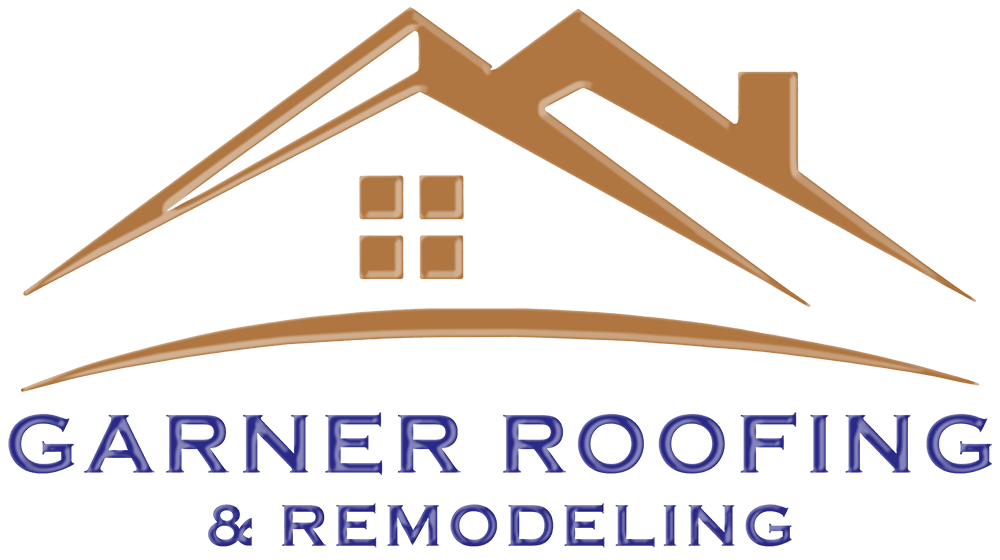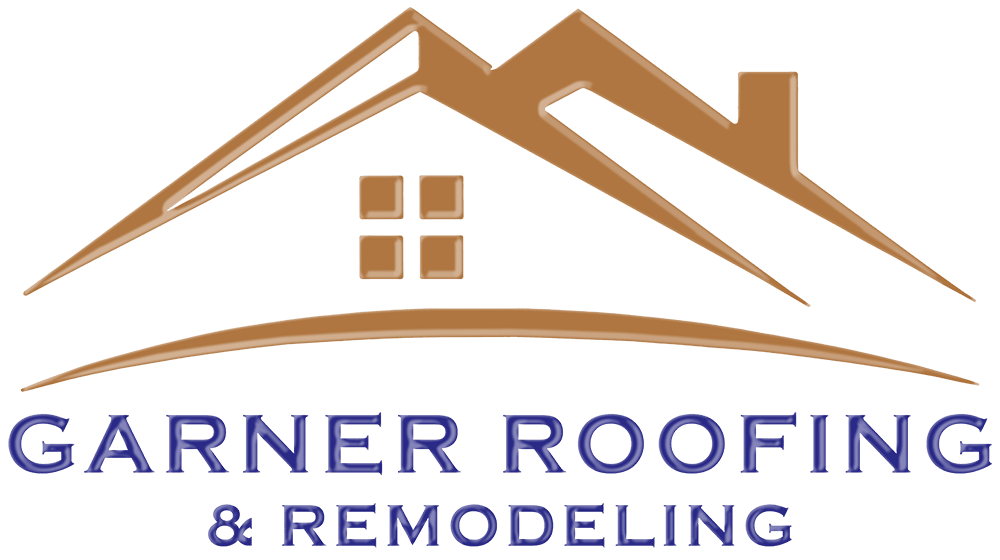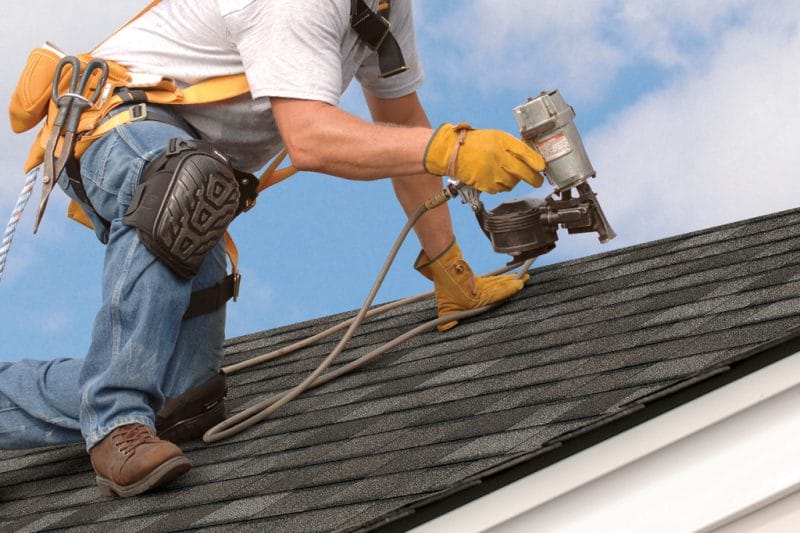
A lot of homeowners take their roofs for granted. As long as it’s keeping the rain out, then the roof goes unnoticed.
However, your roof is actually one of the most important parts of your home, and homeowners need to make sure their roofs are in peak shape.
You may be asking yourself “how to tell if I need a new roof?” or “how long does a roof last?” These are important questions that can guide your future roofing plans. That’s why we’ve decided to put together a guide on roof repair and replacement. We will discuss the various signs indicating you need a roof replacement, ranging from roof leaks and tired-looking shingles to addressing storm damage.
So if you’ve recently found yourself asking “what are the signs I need a new roof?” join us as we help you decide!

Lifespans of asphalt shingles, cedar shake shingles, synthetic shingles, natural slate shingles, synthetic slate shingles, metal, and rubber roofs.
START WITH AGE
While there are a number of visual cues that indicate the need for a roof replacement, your first consideration should always be the age of your roof.
Of course, the type of roofing installed on your home will determine its life expectancy. Consider these recommendations:
- Asphalt Shingles: These are the most common roof type and they generally last 20 to 30 years depending on the shingle type and quality. However, if you live in a sunny, warm climate, you may find your asphalt roof can age much faster. Some types of modern asphalt shingles are designed to last much longer.
- Cedar Shakes/Shingles: This beautiful roofing material typically lasts approximately 25 years
Synthetic Cedar: Considering the cost of traditional cedar, this alternative increases the lifespan to 50 years
Natural Slate: This is a very durable roofing material, as slate roofs can easily last 70 to 100 years - Synthetic Slate: A more affordable slate alternative, these roofs last about 50 years
- Metal: You can expect 50 years out of a modern metal roof
- Rubber: Used primarily on flat roofs, modern rubber can last 30 to 50 years
- So how old is your roof? If your roof is reaching its life expectancy, even a small issue may still warrant a full replacement, as repairs are no longer cost-effective.
You also want to keep roof age in mind if you are putting your home on the market. Most home sales today involve a roof inspection so the age and condition of your roof can really help or hurt you. A new roof with a transferable warranty will make your home more attractive on the market and give you a better chance of finding a buyer willing to pay your asking price.
Roofers laying new shingles on a roof.
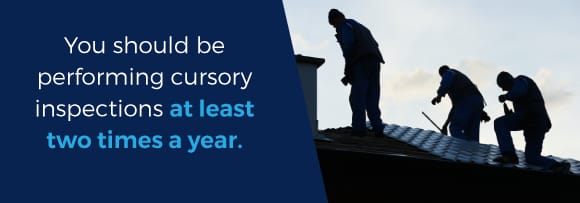
PERFORM REGULAR INSPECTIONS
While there are certain roofing issues that are usually only visible to a professional, you should be performing cursory inspections at least two times a year.
We suggest performing these inspections in the fall and spring. That way you can catch issues before the punishing summer sun or the weight of winter snow.
While you might expect a roof inspection to require going outside onto your roof, we actually recommend doing your inspection from the inside. Take a flashlight and head up to your attic. Look for places where you might see water staining, wood decay, noticeable sagging, dark spots or even points of light shining through the attic ceiling. All of these things can be signs of roof problems.
If you spot any of these warning signs, call a professional to give your roof a more thorough inspection. Not only will you be getting a better sense of repair or replacement needs, but by keeping your inspection indoors, you will eliminate the significant risk of injury that comes with venturing out onto your roof.
Large tree laying on top of a roof and causing damage to the home after a storm.
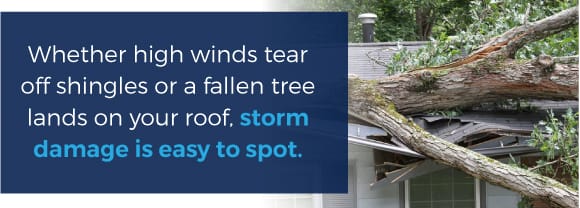
STORM DAMAGE
For many homeowners, their first experience with roof repairs or replacements come as the result of obvious storm damage. Whether high winds tear off shingles or a fallen tree lands on your roof, storm damage is easy to spot and important to address right away.
Storm damage also presents unique considerations. First and foremost, storm damage means insurance companies are likely to be involved. As such, you will want to have your roof inspected first by an insurance adjuster. The adjuster will determine the amount of insurance reimbursement you are entitled to.
Of course, insurance companies will always opt for a repair if it is cheaper than a total replacement. Even if they only cut you a check to cover a significant repair, you can still put that money toward a completely new roof.
It is also important to have your roof inspected after any potential storm damage, even if you cannot see any visual issues. Minor storm damage often requires a professional eye, and these kinds of issues can become much bigger problems if left unaddressed. An unseen hole in your roof can grow, leading to significant water damage further down the line.
LEAKY ROOFS
Even if you haven’t recently experienced storm conditions, you may eventually find a leak in your home. You may wonder whether repairs or replacements are in your future.
So when does a leak require a simple repair and when does it warrant a full replacement?
If this is your first leak, mostly likely a repair will be sufficient. There are a number of potential causes, but a single leak is usually an isolated incident. The same is true if the water spotting is located in a specific area of the home. If so, you have a single problem that can probably be addressed with a simple repair.
You should also consider when the leak occurred. Was it after a heavy rain? If so, your roof may not be the problem, but rather a faulty gutter system or an issue in your siding. Keep in mind, heavy rains are a worst-case scenario for leaks, so a small issue can still result in noticeable leaking.
yep!However, if you have had a number of leaks or the water damage seems to span a number of areas in your home, that is a symptom of much larger problems. If numerous leaks are coupled with an aging roof, you are probably witnessing the general failure of your roof as a whole. Even with a newer roof, if you have multiple leaks, the cost of repair can escalate quickly to approach the cost of replacement.
UNSIGHTLY STAINS AND STREAKS
Can you spot dark streaks on your roof? They are unsightly and many homeowners go to great lengths to remove them.
The most common cause of staining comes from airborne algae. The algae won’t harm the functionality of your roof, but if you are worried about curb appeal or resale value, it is still worth addressing.
If you have an asphalt shingle roof, you can use a water/bleach solution to remove the staining. However, you have to be careful not use a high-pressure hose to rinse the roof and do not scrub the shingles with anything abrasive because you don’t want to remove the protective granules from the surface of your shingles.
Furthermore, you always want to be careful when doing any roof work, so if you can’t spray the solution without venturing out onto your roof, we recommend consulting a professional.
A roof with damaged and missing shingles.
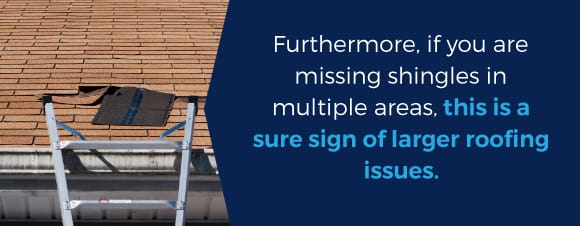
SHINGLE REPLACEMENT
Another common issue for homeowners is missing shingles. When do missing shingles require repairs and when do they require a full roof replacement?
If you are only missing a few shingles and they are restricted to one area, you most likely only require a repair. There are a lot of reasons why a couple of shingles may be missing. A few individual shingles may have been defective, or perhaps they were improperly nailed. Regardless, replacing a few shingles when they are not indicative of a larger issue is an easy and affordable fix.
Furthermore, if you are missing shingles in multiple areas, this is a sure sign of larger roofing issues. Those shingles have most likely failed because they have aged to the point that they are no longer effective or they are defective in some other way. If so, it is likely your remaining shingles are in similar condition and your best bet is a complete roof replacement.
OTHER SIGNS OF SIGNIFICANT SHINGLE ISSUES
There are a number of other indicators of larger roofing issues. In each case, these symptoms usually indicate the need for a full roof replacement.
Curling
There are a number of issues that could cause your shingles to curl. Most of the time they will curl upward and other times they curl under.
This could be due to nails inching out of your roof. As temperature and moisture cause expansion and contraction of your decking, the nails will slowly be pushed out of the wood. As they do, they push up the shingles that overlap them.
Improper roofing installation can also cause significant curling. There are two common installation issues that are usually the result of amateur work. The first is a misalignment between the adhesive strip and the overlapping shingle. With asphalt shingles, there is a small adhesive strip that is designed to seal the lower shingle to the backside of the upper shingle. When this strip doesn’t line up with its intended point of contact, curling is likely to occur.
The second most common installation issue is skip nailing. This occurs when a roofer, in an effort to move more quickly, does not adhere to manufacturer recommendations and uses fewer nails per shingle.
Finally, if your attic ventilation is insufficient, you may also experience shingle curling. If this is the case, you will likely still need to replace your roof, but you also want to make sure to address the ventilation issue at the same time, as you do not want your new roof to suffer the same fate.
Buckling
Buckling occurs when sections of your shingles start to lift off your roof and form a ridge. There are a number of related causes of buckling, and most are the result of improper roof installation.
There is a layer between your shingles and your roof. For many roofs, a felt layer – alternatively known as a tar paper layer – is installed. This serves as a vapor barrier between your plywood decking and your shingles. In high moisture areas, an underlayment which is adhesive may be installed. These work much the same way, but are even more effective at keeping out moisture.
However, if either of these layers is improperly installed, either because they were not stretched taut or not properly nailed to the decking, they can cause your roof to buckle.
Your decking could also move over time, again because it was improperly installed. This will also cause buckling.
Either way, if you want to repair buckling, you must first address the cause, which can usually only be done with a complete roof replacement.
Blistering
The most common cause of blistering is poor attic ventilation, although manufacturing defects with the shingles or the use of improper caulks or other sealants during installation can also be the cause. Unfortunately, it is unlikely that blistering is isolated to just a few shingles, so this is usually a sign of a full roof replacement.
RUBBER ROOF REPLACEMENT SIGNS
Not everyone has asphalt shingle roofing. If you happen to own a rubber roof, the various signs of larger roofing problems are different.
The most obvious sign is bulging. Bulging in a rubber roof is caused by a warped or bowed insulation board. This indicates that moisture has begun to penetrate the roof.
You may also notice low areas on your rubber roof. Those are typically caused by the deterioration of the insulation board. Again, this is often a sign that moisture has penetrated the insulation layer. However, keep in mind that there can be several other causes. Depending on the type of material used in the insulation layer, it may have become compressed physically, in which case a roofing replacement is not necessary.
Does your rubber roof look wrinkled? If your rubber roof is properly adhered, you should be able to see the outlines of the plates holding down the insulation beneath the roof. If moisture has penetrated the roof, you will notice the adhesive has been worn away, causing the roof to wrinkle and detach from the insulation layer.
Finally, if you notice water emerging from the seams of your rubber roof, there can be only one cause: leaking.
If you spot any of these issues, make sure to have your rubber roof professionally inspected. While there may be repair options available, it is likely that a roof replacement is the best option.
COUNT ON GARNER ROOFING
If you are looking to either have your roof repaired or replaced and you live in Harford or Baltimore County, Maryland, look no further than Garner Roofing.
Our company is family owned by native Marylanders, so we understand the specific needs of Maryland homeowners. We can ensure your roof is installed in a way that is tailored to the unique weather conditions and climate of the Chesapeake Bay.
Considering how many roofing issues are caused by improper, amateur installations, it is important that you have a roof that is properly and professional installed. In fact, this will save you money in the long run, as a properly installed roof will last longer and require fewer repairs down the road.
Whether you are in need of a professional repair or replacement, contact us today. You can count on us, because we always deliver on what we promise!
